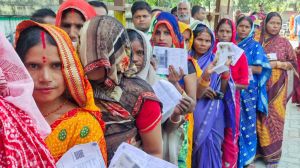Anonna Dutt is a Principal Correspondent who writes primarily on health at the Indian Express. She reports on myriad topics ranging from the growing burden of non-communicable diseases such as diabetes and hypertension to the problems with pervasive infectious conditions. She reported on the government’s management of the Covid-19 pandemic and closely followed the vaccination programme. Her stories have resulted in the city government investing in high-end tests for the poor and acknowledging errors in their official reports. Dutt also takes a keen interest in the country’s space programme and has written on key missions like Chandrayaan 2 and 3, Aditya L1, and Gaganyaan. She was among the first batch of eleven media fellows with RBM Partnership to End Malaria. She was also selected to participate in the short-term programme on early childhood reporting at Columbia University’s Dart Centre. Dutt has a Bachelor’s Degree from the Symbiosis Institute of Media and Communication, Pune and a PG Diploma from the Asian College of Journalism, Chennai. She started her reporting career with the Hindustan Times. When not at work, she tries to appease the Duolingo owl with her French skills and sometimes takes to the dance floor. ... Read More
Chikungunya vaccine linked to death: Why US FDA suspended licence for the shot
Serious adverse events noted in recipients; clinical benefits of vaccine yet to be verified
 Dominating circulating strains can change between hemispheres and every year each hemisphere gets a flu vaccine recommendation to last that year. (File Photo)
Dominating circulating strains can change between hemispheres and every year each hemisphere gets a flu vaccine recommendation to last that year. (File Photo)The United States Food and Drug Administration (FDA) has suspended the licence of one of the two chikungunya vaccines available in the country, following chikungunya-like illness in recipients of the shot. Chikungunya is a viral infection transmitted by the same mosquito that spreads dengue — many of its symptoms also mimic that of dengue such as fever, headache vomiting and rashes. However, its distinctive feature is severe and persistent joint pain.
“This vaccine was initially approved by the FDA under the accelerated approval pathway in November of 2023 … (The) decision is based on serious safety concerns related to the vaccine,” according to a statement from the regulatory agency.
What were the findings that led to the US FDA suspending the vaccine licence?
The IXCHIQ vaccine, which uses a live, weakened form of the virus to elicit an immune response, was initially approved for use in adults travelling to an area with a chikungunya outbreak and laboratory workers who might be exposed to the virus.
This year in May, US FDA recommended a pause on the use of the vaccine in people over the age of 60 years after reports of serious adverse events in older individuals, including hospitalisation for cardiac and neurologic complications. The pause was lifted earlier this month with an additional warning on adverse events in people aged 65 years and above with one or more chronic medical conditions.
The US FDA decided to suspend the licence for the vaccine after reports of 21 cases of serious adverse events consistent with chikungunya-like illness and three deaths, of which one death with brain inflammation can be directly attributed to the vaccine. When the cerebrospinal fluid of the deceased was tested, it was found to be positive for the exact same strain of the virus as the vaccine.
Additionally, the clinical benefits of the vaccine are yet to be verified by confirmatory clinical trials. The statement from the US FDA said: “FDA’s Center for Biologics Evaluation and Research (CBER) benefit-risk analysis broadly shows the vaccine does not have benefits outweighing risks, under most plausible scenarios. For these reasons, CBER believes this vaccine is not safe and that continued administration to the public would pose a danger to health.”
What is the other chikungunya vaccine and who is it meant for?
Called VIMKUNYA, the other chikungunya vaccine is approved for use in people over the age of 12 years. The vaccine uses a laboratory-made virus-like particle to elicit an immune response and is recommended for use in adults and adolescents travelling to areas with chikungunya outbreak and laboratory workers at risk of exposure to the virus.
While the two vaccines received regulatory approval in the United States and several other countries, they are not yet widely available or used at present, according to the World Health Organisation. “WHO and external expert advisors are reviewing vaccine trial and post-marketing data in the context of global chikungunya epidemiology to inform possible recommendations for use,” states WHO.
While there is no specific treatment for the disease, severe symptoms and deaths are usually rare, occurring mainly in young babies or elderly people with co-morbid conditions.
Is there a need for a chikungunya vaccine in India?
India was one of the first few countries to record chikungunya outbreaks. The National Vector Borne Disease Control Programme — which maintains data on vector borne diseases such as dengue, malaria, kala azar among others — does not maintain figures on deaths due to the infection.
There were 1,741 laboratory confirmed cases of chikungunya in the country till March-end, with 30,876 more suspected cases. Last year, there were 17,930 confirmed and 2.4 lakh suspected cases recorded in the entire year.
There is at least one chikungunya vaccine in development by the Indian biotech company Bharat Biotech. Unlike the single-dose vaccines approved in the US, the Indian vaccine candidate has three escalating doses to be administered on Day 1, Day 29, and Day 57 as per trial details.



- 01
- 02
- 03
- 04
- 05





























